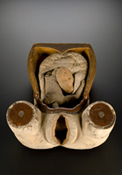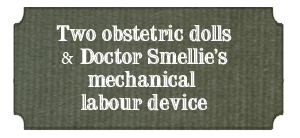
Although Smellie made his forceps publicly accessible, reproducing drawings of them and sharing the technology widely, there are no extant drawings of the famous ‘machine’, so it is not known exactly what it looked like. 6 Above is a similar obstetric phantom of the time (Italy, 1701-1800), housed at the Wellcome Trust in London. (copyright Wellcome Trust Science and Society Picture Library)
DR. SMELLIE'S MECHANICAL LABOUR DEVICE
Smellie felt that: “In order to acquire a more perfect idea of the art, [the male midwife] ought to perform with his own hands upon proper machines, contrived to convey a just notion of all the difficulties to be met with in every kind of labour; by which means he will learn how to use the forceps and crotchets with more dexterity, be accustomed to the turning of children, and consequently, be more capable of acquitting himself in troublesome cases.”1
Upon returning to London from Paris in 1739, Smellie began creating his own female models out of real pelves, with ligaments, muscles and skin in artificial materials, and cloth dolls to simulate the fetus. He would get a student-volunteer to deliver the doll while he shifted the levers to imitate the actions of the maternal abdomen. The womb was represented by a glass carafe turned upside down, with a doll positioned inside to show different possible breech births. 2 By 1747 Smellie had three machines, with six ‘artificial children’. He continued to develop the dolls: one for example had a head that separated from the body in order to demonstrate the difficult situation in which the head remained in the uterus after the rest of the body of a deceased infant had been extracted with instruments.3
One possible design inspiration for Smellie’s machine exists at the Museum of Flaubert and the History of Medicine in Rouen, France ⬀.4 The model was created by French midwife Louise du Coudray, who, between 1740 and 1760, manufactured hundreds of her birthing mannequins to teach midwifery, first in Paris and then to over 4000 midwives in the countryside of France. Her models were of soft sponge built on human pelvic bones with linen dolls, as well as clear and red fluids which recalled the glass veins and arteries of the model of circulation between the fetus and the mother.5 All of these different ‘machines’ represent the humble beginning of the obstetric simulation model, also known as a partial-task trainer, modern variations of which are still used today in obstetrics training. ➡
NOTES | 1. Smellie, 1756, p44 --- 2. Blackwell, 2001 --- 3. King, 2007
4. Musées en Haute-Normandie, 2012 --- 5. King, 2007 --- 6. Blackwell, 2001
⬀
external link
